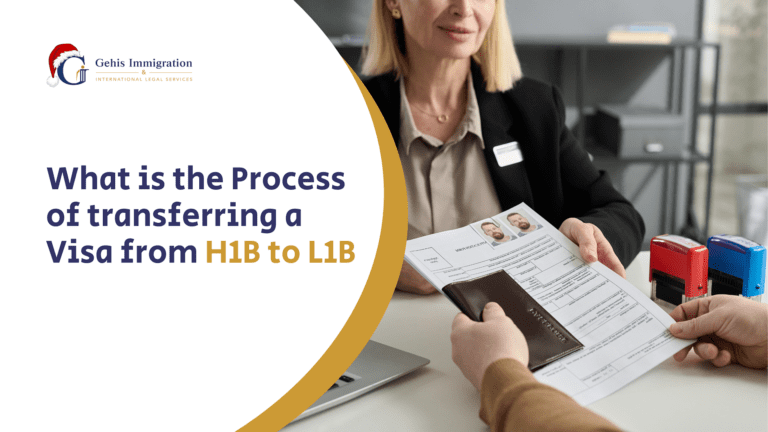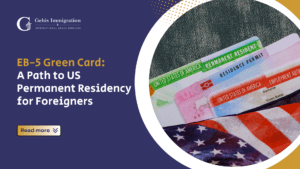The Process of transferring H-1B to an L-1B visa are two common non-immigrant visa categories in the United States, each serving distinct purposes for foreign nationals seeking employment. Understanding differences between H1-B and L1-B & need to transfer from H-1B to L-1B is crucial for individuals in the complex U.S. immigration system.
What are H-1B and L-1B Visas?
H-1B Visa
The H-1B visa is designed for foreign workers in specialty occupations requiring higher education or specialized skills.
Employers sponsor H-1B visa holders, allowing them to work in the U.S. for a specific employer for a predetermined period, usually up to six years.
IT, engineering, science, and medicine professionals often seek H-1B visas.
L-1B Visa
The L-1B visa is for intracompany transferees with specialized knowledge who work for a multinational company.
It allows employees to transfer from a foreign office of their company to a U.S. office for a temporary period.
L-1B visa holders may stay in the U.S. for up to five years, with extensions possible, and it facilitates the transfer of employees with unique or advanced knowledge within the company.
What is The Need for Visa Transfer from H-1B to L-1B?
There are various reasons why someone on an H-1B visa might consider transferring to an L-1B visa, including:
Suppose an individual working for a multinational corporation on an H-1B visa is offered a U.S. position requiring specialized knowledge within the same company. In that case, they may opt for an L-1B visa.
Employees may prefer an L-1B visa to transfer from the same company to a U.S. office and continue utilizing their specialized skills.
A transfer might be warranted if an H-1B visa holder’s job responsibilities align more with the criteria for an L-1B visa, such as specialized knowledge within the company.
A clear understanding of these visa categories and the transfer process is vital for those seeking employment opportunities in the U.S., ensuring compliance and optimizing the benefits provided by each visa.
What is H-1B Visa?
The H-1B visa is a non-immigrant category in the United States designed to facilitate the temporary employment of foreign workers in specialty occupations.
Specialty occupations typically require specialized knowledge and a minimum bachelor’s degree in a specific field.
Eligibility criteria for the H-1B visa include the applicant’s educational qualification, job requirements aligning with a specialty occupation, and establishing a clear employer-employee relationship.
To initiate the application process, employers must obtain an approved Labor Condition Application (LCA) from the Department of Labor, ensuring compliance with prevailing wage levels and working conditions.
The H-1B visa process involves employer sponsorship, where the employer submits a petition (Form I-129) to the United States Citizenship and Immigration Services (USCIS) on behalf of the prospective employee. The approved LCA and other necessary documentation support this petition.
Following USCIS review and approval, the employee can apply for an H-1B visa at a U.S. consulate or embassy abroad.
Initially granted for up to three years, H-1B visas can be extended, with a maximum cumulative stay of six years. Extensions beyond the six-year limit, such as pursuing employment-based permanent residency under certain circumstances, may be feasible.
H-1B holders can change employers, but the new employer must file a new H-1B petition. It’s crucial to note that H-1B visa regulations may change, necessitating consultation with an immigration attorney or regular checks on the USCIS website for the latest information.
What is an L-1B Visa?
The L-1B visa is a non-immigrant visa category in the United States. It facilitates the intra-company transfer of employees with specialized knowledge from a foreign company to its U.S. branch, subsidiary, affiliate, or parent company. This visa is part of the broader L-1 visa category, including the L-1A visa for managers and executives.
To be eligible for an L-1B visa, there must be a qualifying relationship between the U.S. and foreign companies. The U.S. employer must be a foreign employer’s branch, subsidiary, affiliate, or parent company. Both the U.S. and foreign entities must be actively doing business.
Employee eligibility for the L-1B visa requires the applicant to have been employed by the foreign company for at least one year within the past three years.
Moving on to the specialized knowledge requirement, the L-1B visa is for individuals possessing specific expertise. Specialized knowledge encompasses a deep understanding of the company’s products, services, research, equipment, techniques, management, and other facets and their application in international markets.
This knowledge can manifest as an advanced proficiency in the organization’s processes and procedures.
Specialized knowledge must surpass ordinary knowledge and be unavailable in the U.S. labor market, serving as a pivotal criterion for L-1B visa eligibility. The application process involves the U.S. employer filing a petition with the United States Citizenship and Immigration Services (USCIS) on behalf of the employee, accompanied by documentation substantiating the qualifying relationship between U.S. and foreign companies, the employee’s one-year foreign employment, and evidence supporting the specialized knowledge requirement. Initially granted for up to three years, L-1B visas are subject to extensions in two-year increments, reaching a maximum of five years.
L-1B visa holders can maintain “dual intent,” allowing them to pursue permanent residency (green card) while holding L-1B status. This visa category offers a valuable avenue for multinational companies to transfer specialized knowledge to employees in the U.S., fostering the exchange of skills and expertise within the organization. As immigration regulations may evolve, staying informed and consulting with legal professionals are essential for up-to-date guidance.
Reasons for Transferring from H-1B to L-1B
One common reason for transferring H-1B to an L-1B visa is a change in employment circumstances. Suppose an individual initially entered the U.S. on an H-1B visa, but their employer undergoes structural changes, such as becoming a subsidiary or affiliate of a foreign parent company. The employee may become eligible for an L-1B visa in that case. The L-1B allows intra-company transfers and is specifically designed for employees with specialized knowledge.
The L-1B visa category is ideal for intra-company transfers within multinational corporations. Suppose an employee on an H-1B visa is presented with an opportunity to work in the U.S. branch, subsidiary, affiliate, or parent company of their current employer. In that case, they may transition to an L-1B visa to take advantage of this intra-company transfer opportunity. This allows for a seamless transfer of employees with specialized knowledge across borders.
Advantages of L-1B Visa Over H-1B for Certain Situations:
The L-1B visa is specifically for employees with specialized knowledge, making it advantageous for individuals whose roles align more closely with this criterion. H-1B visas, on the other hand, cover a broader range of specialty occupations.
The L-1B visa provides greater flexibility for intra-company transfers within multinational organizations. If an individual’s work involves specialized knowledge integral to the company’s operations in both the home country and the U.S., the L-1B visa may be more suitable.
Unlike the H-1B visa, the L-1B visa has no prevailing wage requirement. Employers do not have to pay the prevailing wage for their occupation in the geographic area of employment to the L-1B visa holder.
L-1B visa holders can have “dual intent,” meaning they can pursue permanent residency (green card) while holding L-1B status. This can be beneficial for individuals seeking long-term opportunities in the U.S.
What is The Eligibility for H-1B to L-1B Visa Transfer?
Meeting the specialized knowledge criteria is crucial for H-1B visa holders seeking a transfer to an L-1B visa. Specialized knowledge, in the context of the L-1B visa, involves possessing advanced or unique knowledge of the company’s products, services, research, equipment, techniques, management, other interests, and its application in international markets.
Specialized knowledge goes beyond the ordinary and is not readily available in the U.S. labor market. It is essential to demonstrate that the applicant’s knowledge is distinctive and plays a significant role in the company’s operations.
To establish eligibility, the applicant must provide evidence of their unique skills and expertise that qualify as specialized knowledge. This may include documentation of their work experience, specific projects, or contributions that showcase their advanced understanding and application of specialized knowledge within the organization.
Another critical aspect of the H-1B to L-1B transfer is ensuring a qualifying relationship between the U.S. and foreign employers. The U.S. employer must be a foreign employer’s branch, subsidiary, affiliate, or parent company. Both entities must be actively doing business.
Final Word
Transferring from an H-1B to an L-1B visa involves several key steps. Initially, individuals meet the specialized knowledge criteria for the L-1B visa, demonstrating advanced and unique expertise in the company’s operations. This includes showcasing skills beyond the ordinary and not readily available in the U.S. labor market. Establishing a qualifying relationship between the U.S. and foreign employers is imperative, ensuring U.S. entity is a branch or parent company of the foreign employer.
Throughout this transition, seeking legal counsel is important for a smooth and successful process. Immigration attorneys can provide valuable guidance on the specific requirements, assist in compiling the necessary documentation, and ensure compliance with the regulations governing H-1B to L-1B transfers. Their experience can help in potential challenges, increasing the likelihood of a favorable outcome.





